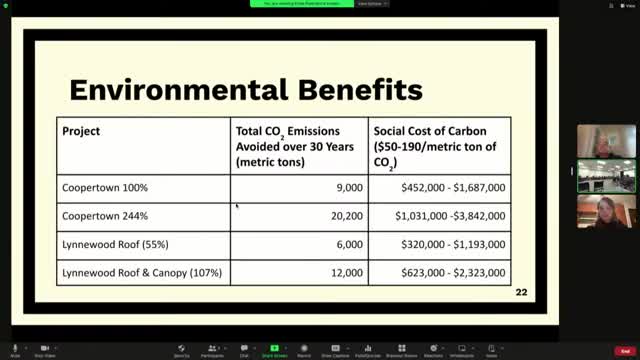
This article was created by AI using a video recording of the meeting. It summarizes the key points discussed, but for full details and context, please refer to the video of the full meeting. Link to Full Meeting
The presentation utilized the Philadelphia Solar Energy Association's Solar Schools Toolkit to evaluate various scenarios over a 30-year period. Four distinct financial cases—optimistic, middle, conservative, and mixed—were examined to assess the impact of different assumptions, including panel costs, bond financing rates, and solar renewable energy credits (SRECs), which are currently valued at approximately $35 per megawatt-hour.
Key findings indicated that, except for the conservative case, all scenarios could yield financial benefits for the school districts over the 30-year lifespan of the projects. The analysis revealed that the net present value of savings varied significantly, with the most optimistic case showing a potential gain of up to $200,000, while the conservative case resulted in a negative net present value.
The discussion also addressed the implications of peak demand reduction on electricity bills, noting that this charge can constitute nearly half of a school’s energy expenses. The analysis emphasized the importance of timing in energy generation, as solar panels may not produce energy during peak usage periods.
Additionally, the Inflation Reduction Act (IRA) was highlighted as a crucial factor, providing a rebate of 30% for nonprofit organizations undertaking solar projects. This rebate could be adjusted based on the financing structure, potentially increasing the net savings for the districts.
In a shift from previous assumptions, it was noted that the school district may opt to finance the solar projects through capital funds rather than bonds, which could enhance overall savings and eliminate the burden of loan repayments. This change could lead to improved financial outcomes across all scenarios, with the exception of the conservative case.
Overall, the meeting underscored the financial viability of solar energy projects for local schools, with the potential for significant long-term savings and environmental benefits. The officials concluded the session by inviting questions, indicating a commitment to transparency and community engagement in the decision-making process.
Converted from 10/17/24 Finance and Facilities Committee Meeting meeting on October 17, 2024
Link to Full Meeting
Comments
View full meeting
This article is based on a recent meeting—watch the full video and explore the complete transcript for deeper insights into the discussion.
View full meeting